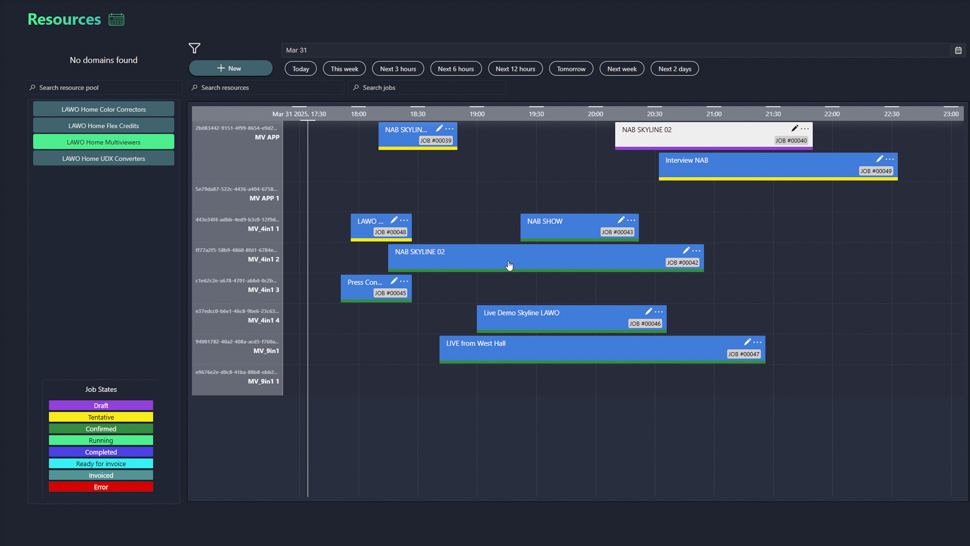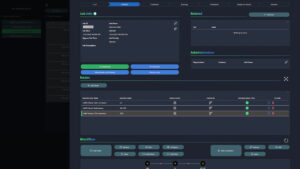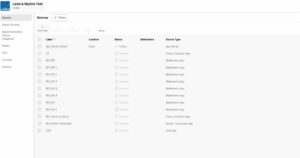“`html
Skyline and Lawo Debut Resource Planning Solution at NAB 2025 for Dynamic Media Facilities
Table of Contents
- 1. Skyline and Lawo Debut Resource Planning Solution at NAB 2025 for Dynamic Media Facilities
- 2. Automated Planning and Resource Provisioning
- 3. Addressing the Challenges of Dynamic Media Environments
- 4. Seamless Operation Across Infrastructure layers
- 5. Preventing Resource Conflicts
- 6. What impact does this new dynamic resource management solution have on broadcasters’ ability to manage costs?
- 7. Dynamic Resource Management in Broadcasting: An Interview with Thomas Gunkel of Skyline Communications
- 8. Introduction
- 9. Interview with Thomas Gunkel
- 10. Call to Action
By Archyde News
LAS VEGAS — Skyline Communications, the force behind the DataMiner XOPS platform, and Lawo, a leader in broadcast technology, jointly unveiled a groundbreaking technology demonstration at NAB 2025, held in Las Vegas, NV. The demo showcased a collaborative solution designed to address the burgeoning need for dynamic resource management within modern media facilities. As the broadcast industry increasingly embraces software-defined workflows, the ability to efficiently allocate and manage resources is becoming paramount.

the initiative aligns perfectly with the “Dynamic Media Facility” concept, gaining traction within the European Broadcasting Union (EBU) and various broadcasting entities across north America. This movement champions the transition towards hardware-autonomous processing applications, provisioned dynamically to optimize the utilization of available computing power. This is especially relevant in the U.S. market, where media companies are constantly seeking ways to streamline operations and reduce costs, mirroring efforts like those seen with cloud adoption across various sectors.
For U.S. broadcasters, this translates to increased agility. imagine a scenario where a local news station needs to quickly spin up additional resources for election night coverage. With a dynamic resource management system, they could allocate processing power and licenses on-demand, avoiding the need to invest in expensive, underutilized hardware. This approach is akin to how Amazon Web Services (AWS) allows companies to scale their computing resources up or down as needed, paying only for what they use.
Automated Planning and Resource Provisioning

The joint demonstration centered around an automated planning and resource provision tool specifically designed for managing the lifecycle of Lawo Home Apps. Thomas Gunkel, Market Director Broadcast at Skyline Communications, emphasized the potential of the collaboration, stating, Even though we are still at the beginning, we are convinced that our cooperation paves the way for a highly automated and efficient management of dynamic resources. Dataminer will not only start, stop and automate the configuration of home apps, but also keep an eye on the available home credit to ensure that planned home apps always have sufficient license credit for future missions.
This system aims to streamline operations by automating the allocation of resources, including processing power and licenses. This automation is crucial for broadcasters looking to optimize their workflows and reduce the operational overhead associated with managing complex media environments.Imagine a scenario where a sports network needs to quickly provision resources for a live broadcast. This system would automate the process, ensuring that all necessary resources are available on time and without manual intervention. in the context of the U.S. market, where skilled broadcast engineers are in high demand (and frequently enough short supply), automation offers a compelling value proposition.
Addressing the Challenges of Dynamic Media Environments

Axel Kern, Senior Director of Cloud and infrastructure Solutions at Lawo, highlighted the transformative potential of software-based signal processing, stating, With the advent of software-based signal processing for live productions, media companies are given the opportunity to change their production environments dynamically.In order to exploit the full potential of a dynamic media surroundings, an orchestration layer is required that fully automates the provision of processing applications, licenses, CPU and network capacities.
Kern’s statement underscores the necessity for a robust orchestration layer to manage the complexities of dynamic media environments. This orchestration layer acts as a central control point, automating the provisioning of processing applications, licenses, CPU, and network capacities. This is particularly relevant for U.S. media companies that are increasingly relying on cloud-based solutions and virtualized infrastructure.
Seamless Operation Across Infrastructure layers

The NAB presentation leveraged Skyline’s MediaOps solution to monitor processing resource utilization and application requests across all infrastructure layers. This ensures seamless, collision-free operation through an intuitive user interface. By tracking resource consumption and proactively managing potential conflicts, the system helps broadcasters avoid costly downtime and maintain optimal performance.
to further illustrate the capabilities,consider a scenario where a major broadcast network is preparing for its Super Bowl broadcast.The network needs to ensure that all resources, including encoders, transcoders, and distribution channels, are available and properly configured. The Skyline MediaOps solution can monitor resource usage in real-time, identify potential bottlenecks, and automatically allocate additional resources as needed. This level of automation and visibility is critical for ensuring a flawless broadcast experience.
Preventing Resource Conflicts
 What impact does this new dynamic resource management solution have on broadcasters’ ability to manage costs?
What impact does this new dynamic resource management solution have on broadcasters’ ability to manage costs?
Dynamic Resource Management in Broadcasting: An Interview with Thomas Gunkel of Skyline Communications
By Archyde News
Introduction
Archyde News had the prospect to speak with Thomas Gunkel,Market Director broadcast at Skyline Communications,following the unveiling of their collaborative resource planning solution with Lawo at NAB 2025. The solution addresses the growing need for efficient dynamic resource management within modern media facilities. We discussed the implications of this technology,particularly for the U.S. broadcast market.
Interview with Thomas Gunkel
Archyde News: Mr.Gunkel,thank you for joining us. Can you start by explaining the core concept of this new solution and how it addresses the needs of broadcasters today?
Thomas Gunkel: Certainly. Our solution, developed in collaboration with Lawo, is centered around automated planning and resource provisioning. ItS designed to manage the entire lifecycle of Lawo Home Apps, allowing broadcasters to dynamically allocate processing power and licenses on demand. The goal is to move away from static, underutilized hardware towards a more agile, cost-effective model, similar to the cloud-based approaches many U.S. companies are already utilizing.It will start, stop and automate the configuration of home apps, plus keep an eye on the available license credit.
Archyde News: The press release mentions the “Dynamic Media Facility” concept. How does this solution align with that trend, and what advantages does it offer U.S. broadcasters specifically?
Thomas Gunkel: The “Dynamic Media facility” is all about hardware-autonomous processing.This solution enables exactly that, allowing broadcasters to optimize their computing resources. For the U.S. market, this translates to increased agility. Think of live events, election coverage, or any instance requiring a sudden influx of processing power. Our system ensures broadcasters can scale up or down quickly, freeing up capital investments. It’s about paying for only what you use – resource planning, which is so crucial to these events.
Archyde News: Your quote in the press release highlighted the potential of this collaboration. can you elaborate on how DataMiner, the core of Skyline’s XOPS platform, integrates with Lawo Home Apps in this new setup?
Thomas Gunkel: DataMiner acts as the central orchestration point. it monitors and manages the entire system, from Lawo Home Apps to the underlying infrastructure.DataMiner is also responsible for ensuring the available license in order to make sure that the planned Home Apps always have sufficient license credit for the production.
Archyde News: In a market where broadcast engineers are in high demand, how does automation fit into optimizing and streamlining the resource management workflow?
Thomas Gunkel: automation is key. By automating resource allocation, we reduce operational overhead, thus allowing these engineers to focus on more complex tasks, like engineering management, not operational busywork. This not only makes operations more efficient but also helps bridge the shortage of skilled personnel.Also addressing a lack of resource management skills, this helps alleviate that shortage.
Archyde News: What are the key challenges in implementing such a dynamic resource management system, and how does your solution address those?
Thomas Gunkel: the main challenges are the complexity of modern media environments and ensuring seamless operations across all infrastructure layers. Our solution uses Skyline’s MediaOps feature to monitor resource utilization and application requests, we eliminate resource conflicts that might occur. It offers an intuitive user interface.this provides broadcasters with real-time visibility and control, proactively preventing bottlenecks and downtime.
Archyde News: Looking ahead, what are the next steps for this collaboration, and what future developments can we expect?
Thomas Gunkel: We are in the early stages, but the potential is vast. We’re planning further integrations and enhancements to support a wider range of broadcast workflows. We’ll be collaborating closely with Lawo to respond to market demand and incorporate feedback from our early adopters. Ultimately, we aim to provide a fully integrated and automated resource management solution, helping broadcasters worldwide to adapt to their dynamic environments.
Archyde News: This sounds like a very exciting growth for the broadcasting industry. What would be the biggest impact of this system?
Thomas Gunkel: The biggest impact is probably on cost control for the broad industry.The efficient use of resources. We want to ensure they are there and use only what they need to provide great content to their viewers.
archyde news: Thank you for your time and insights, Mr. Gunkel. It was a pleasure speaking with you.
Thomas Gunkel: The pleasure was mine. Thanks for having me.
Call to Action
What are your thoughts on the future of dynamic resource management in broadcasting? Share your comments and opinions below.







